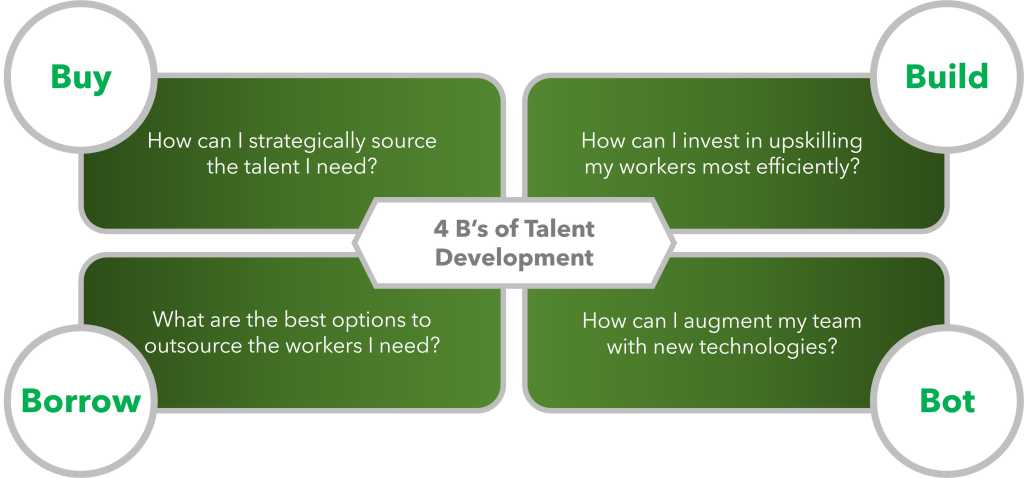With companies placing big bets on technology as a strategic business enabler, the CIO agenda has become more ambitious than ever. In talking with technology executives about how they’re approaching these mission-critical initiatives, I’ve been interested to see where talent falls in the strategy. What I’ve found is that those CIOs who focus on talent first are innovating faster and driving much greater business value with their initiatives.
It’s a finding that is echoed in McKinsey’s latest IT strategy survey, which underscores how important the people side of transformation is. According to the technology executives McKinsey surveyed, talent and sourcing transformations—those initiatives focused on practices to attract, retain and upskill talent—were found to deliver the highest value, both in bottom line and top line impact.
McKinsey calls talent “the holy grail of technology transformations.” It results in the greatest business impact, but it’s not easy to execute—which might be why so many CIOs push it down on the priority list. But as Will Markow, vice president of applied research and talent at Emsi Burning Glass, told me, if talent is the last of your strategic pillars, “Good luck executing on the others, because having the right people and skills is foundational to any strategic undertaking you want to tackle.”
But even if you’re ready to invest in talent and lead with a people-first approach, you can’t build your future-ready workforce if you don’t know what the future-ready skills are—and what skills you already have. As Abbott CIO Sabina Ewing says, “I have to know you to grow you.”
I spoke with Markow recently about how the best CXOs are addressing the talent question, the skills that will give organizations “first-mover advantage” and how to optimize your workforce strategy in today’s highly competitive market for tech talent. What follows are highlights from that conversation.
Dan Roberts: You essentially use big data to pinpoint the capabilities that every person in every role and in every industry needs across the workforce. From that, you’ve identified the new foundational skills of a digital economy. Can you break that down for us?

Will Markow, VP of applied research and talent. Emsi Burning Glass
Emsi Burning Glass
Will Markow: These are the different foundational capabilities that workers in every role, technical or not, are going to need to thrive in a digital economy. They’re also the skills that every organization is going to need to become a digitally transformed organization.
Technology leaders are acutely aware of the need to have not just technical expertise but also human skills—the ability to connect what you’re doing in a way that has value for internal and external stakeholders. Because you can have all the digital building blocks on your team, but if you don’t know how to connect those capabilities with how they actually add value to other people, or the people who have them don’t know how to interact on a human level with other teams and other individuals throughout the company, then your digital transformation efforts are going to fall flat.
We find that the highest performing teams and individuals, technical or otherwise, have a strong mix of all three buckets of skills: the digital skills, the human skills, and the business-enabling skills that enable them to connect what they’re doing with why they’re doing it in support of broader strategic and business imperatives.
You emphasize the importance of investing in the skills that will give you “first-mover advantage.” What does that mean?
You gain first-mover advantage by understanding what the emerging skills are and then investing in the disruptive skill sets—those “skills of mass disruption”—that are growing fastest and have the highest value. The faster you can build up these future-ready skills, the bigger advantage you’ll have.
This isn’t just about hiring. It’s also optimizing your reskilling ROI, because if you can develop some of these skills internally, then you’re going to be able to embed them in your workforce much faster than if you go out and try to hire them from a very scarce talent pool. The value that they’re going to add is going to be many multiples of the training investment that’s required to prepare your workers for those skills.
And then there’s what we call “last-mile training.” Workers who come from skill-adjacent fields may already have many of the foundational skill sets that you can build upon and bring them up to a level of proficiency quite quickly in some of these emerging skill areas. Training them in some of those last-mile skills will help make them more future ready as well as more productive and innovative.
We’ve talked about how building a future-ready workforce is really a journey with three parts: Do you know what you have; do you know what “future ready” looks like; and do you have a roadmap to get from here to there. Can you expand a bit on each of those?
Those are definitely key, high-level goals, and it’s easy to say but hard to do, especially if you are flying blind and don’t have clear data on your workforce. Understanding what skills are associated with different workers on your team is absolutely critical as a first step. If you don’t know where you are, you can’t know how to get where you need to go. It’s foundational for almost any strategic workforce planning endeavor.
Then, in terms of being future ready, you have to attack that from multiple angles. What are your strategic goals? If you have those four other pillars in your strategy, what skills are you going to need to execute each of those pillars? Taking an inventory of those capabilities is step one, but then also drawing inspiration from what’s happening in the broader market. Are your peers hiring for new sets of skills or capabilities that you don’t have internally yet? Are there other skill sets that are projected to grow rapidly and add a tremendous amount of value? Are the best-in-breed digital disruptors hiring for new skills that are going to be needed in your industry two years down the line?
For example, unicorns are about 33% more likely to hire for those disruptive future-ready skill sets than their legacy fortune 100 competitors. If you invest in those future-ready capabilities, it will give you a huge leg up on even the most resource-intense legacy firms.
All of this requires you to look both internally and externally to draw inspiration for what your future-ready state needs to look like. And then, in terms of actually executing, how do you get from where you are to where you need to be? That’s where you look at all the different levers at your disposal.
What are those different levers?
We break it down into 4 Bs:
Buy is the traditional way most organizations have thought about going out and getting the talent they need. But they don’t always do it as strategically or holistically as they could be. Especially now, with the rise of remote work, you can look anywhere for the talent you need, so rethinking how you approach that traditional buy strategy is increasingly important.
At the same time, there’s a tepid labor force participation rate and not enough workers to go around. Sometimes you can’t go out and buy the talent you need. So you have to Build it internally. Here’s where you look at how to optimize that reskilling ROI by investing in the skill sets that are going to be hardest to find in the market but high impact for your team to have. You do that by finding those skill-adjacent workers who are most easily upskilled in those last mile skill sets.
Borrow is another strategy to consider, because sometimes there aren’t enough people, and you need a very specialized skill set, and a lot of times, they are concentrated in external firms. It’s just going to be more time and cost effective to go out and borrow that talent.
And then increasingly, as technology evolves, you have the option to Bot. That’s where you can find new automation technologies or other capabilities that can take on some of the rote tasks that humans were doing but can be more efficiently and cost effectively performed by machines.
Figuring out the right mix of each of these is really the goal in building an effective strategic workforce planning roadmap.

Emsi Burning Glass
Remote work has really upended things. Salaries in non-traditional tech hubs have exploded, and if you lose someone, you might have to pay a premium to replace them. Plus, everyone’s fair game in your town now. Before you might have had a captive market of tech workers. Now, there’s no moat around your talent. What advice do you have for CIOs who want to retain their people in this competitive talent market?
When you invest in your people, they want to invest in you. We’ve found that organizations that source their tech talent internally as opposed to externally often have higher retention rates.
If you’re giving people the opportunity to transition between roles, to learn new skills, and you’re investing in them, then they stick around longer, and you get more value out of them. When you look at some of the macro challenges that employers are facing today, in terms of new competitors coming from everywhere, tepid labor force participation rates, and a shrunken talent pool generally as a result of COVID, it becomes absolutely critical to invest in a Build strategy.
Read More from This Article: Q&A: Building a future-ready IT workforce
Source: News


